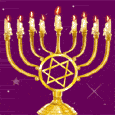|
Wedding Ceremony - Jewish
Wedding Ceremony - Jewish The Jewish wedding ceremony emphasizes that the purposes for marriage in the Bible are for companionship and procreation. In the past, the marriages were usually arranged by parents, but the bride's consent was asked.
Jewish weddings can occur on any day of the week except the Sabbath, Jewish festivals, the three weeks between the 17th of Tammuz and the 9th of Av, and the "sefirah" period Passover & Shavuot (Lag Ba-Omer and other exceptions). In traditional Jewish wedding ceremonies, it is customary for the bride to wear white and a headdress & veil. Jews from oriental countries wear elaborate costumes richly embroidered. The groom may wear a "kitel" (a white garment) along with a tallit. Before the Jewish wedding ceremony, the groom, in the presence of witnesses, undertakes an act of "kinyan" (the obligations of the Ketubah). This is done by the Rabbi taking a handkerchief or some other object, lifting it and returning it. The groom and witnesses then sign the Ketubah. In some traditions the groom is then led to the "Huppah" by two male relatives facing Jerusalem. The bride is led in by the Mothers usually to the accompaniment of a blessing of welcome chanted by the Rabbi. In other traditions, the bride and groom are both escorted to the "Huppah" by both of their parents. Sometimes the bride is led in 7 circles around the groom to ward off evil spirits.
The bride stands to the right of the groom and the Rabbi recites the marriage blessings over a goblet of wine. Both the bride & groom then drink from the glass. The groom places the wedding ring on the forefinger of the bride's right hand and recites the marriage formula. The "ketubah" (marriage contract) is then read and the 7 marriage benedictions are recited. In most ceremonies, the groom then crushes the glass under his right foot and the Rabbi invokes the "priestly blessings". The couple is then escorted away. Jewish men traditionally wear a yarmulke, a skull cap, when in synagogue, for prayer and during religious celebrations; in some sects, it is worn daily. Typically, at a Jewish wedding, yarmulkes are set out on a table outside of the synagogue, and all the male guests attending the wedding are expected to wear one, regardless of their faith.
If it is an Orthodox ceremony, the men and the women will be seated in separate areas, so if you are attending with someone of the opposite sex, expect to be seated separately during the ceremony.
Jewish Wedding Ceremony terms of interest : Huppah: The term was originally referred to as the bridal canopy or bridal chamber. It consists of a cloth spread on four staves. The cloth can be of an elaborate design or a large Talis may be spread over the staves. The Ring: It has become universal Jewish practice to use a ring, except in a few communities where a coin is used. The ring must belong to the bridegroom and be free of any precious stones. In the ceremony, the groom gives the ring to the bride as an act of acquisition and the bride, by accepting it, becomes his wife. Ketubah: It is a document recording, in Aramaic, the financial obligations which the husband undertakes toward his wife in respect of their marriage. It was instituted for the purpose of protecting the woman so that the husband would not find it easy to divorce her.
More on weddings:
Feel free to comment in our Interactive Forum
Wedding Ceremony - Jewish
or our
Rage Page.
|



